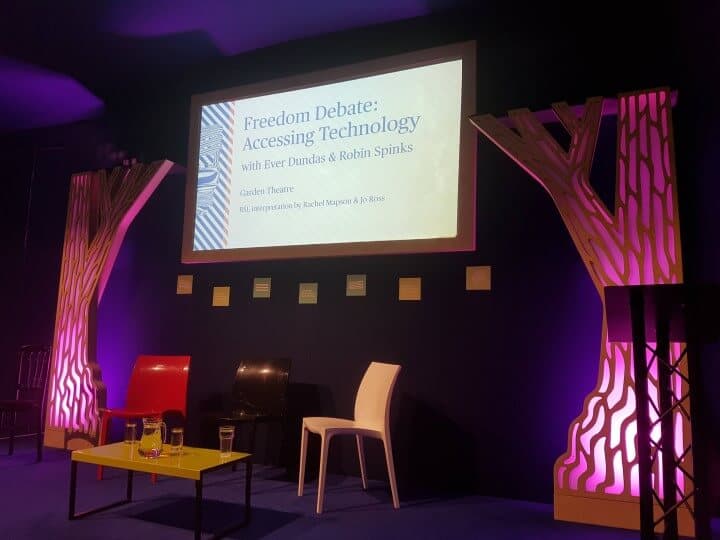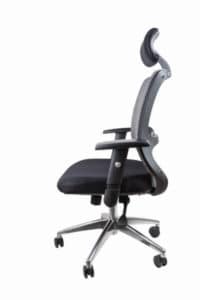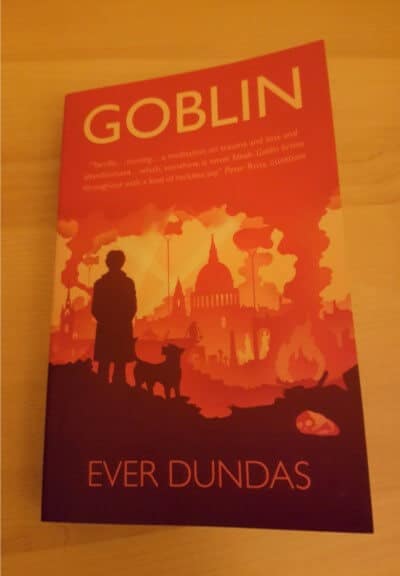
I attended a thought-provoking debate on Accessing Technology at the Edinburgh Book Festival on Sunday, part of their Freedom and Equality series. The precis read:
Technological leaps have expanded opportunities for people with disabilities. At the same time, cuts to resources are making many feel isolated, misunderstood and attacked. How do we ensure everyone has access to the tools they need to live well and feel part of mainstream culture?
Joining the debate were:
- Ever Dundas, writer who won the Saltire First Book of the Year award with her debut novel Goblin.
- Robin Spinks, Innovation and Technology Relationships Manager at RNIB.
Both have personal experience of disability: Ever lives with fibromyalgia, and Robin has a visual impairment.
The broad topic was technology and its positive effects in enabling disabled people to live fuller lives, but the debate covered far more than that.
Here are a few of the themes that were touched upon in the evening.
Society’s views of disabled people: supercrip or super loser
Ever explained that there are two main narratives if you are a disabled person.
You’re either the Paralympian who bravely overcomes their difficulties and acts as inspiration porn.
Or you’re the tragic disabled, an object of pity and disgust.
Most, of course, don’t fit either of these! But there are not many positive alternatives in the media.
A spectrum of disability/ability
The average person is not very good at understanding disability or illness if they haven’t had personal experience of it, or someone close to them has.
You’re either healthy or not, able or not.
How could it be that someone could…
Have a blue badge but not use a wheelchair? (They may only be able to walk limited distances and need to park near their destination, or they might have a hidden condition like autism and be unable to use public transport without distress.)
Be out running in their local park one day, but not be able to work? (They might be partially sighted and have enough local knowledge to get round their locality safely, but this doesn’t mean they could navigate a new workplace.)
Go to a party, then be invisible for days afterwards? (They might have a condition like fibromyalgia or ME where symptoms and energy vary. They could push themselves to go out and spend days afterwards recovering.)
The RNIB have launched the How I See campaign, to try and get across the range of abilities that disabled people have, even if they have the same condition.
Twitter friends, can anybody tell me “WHAT BLIND LOOKS LIKE”?
3 times this week I’ve been told I don’t look blind. Is that based on my looks? Or the fact that I’m independent? This is what I see, but how do you see me? #WhatDoesBlindLookLike #HowISee pic.twitter.com/3TWmTczLOw
— Dr Amit Patel (@BlindDad_Uk) July 20, 2018
A few years ago I volunteered at Number 6 in Edinburgh, a drop-in centre for adults on the autism spectrum or with Aspergers. In their training, they had a saying:
If you’ve met one person with autism, you’ve met one person with autism.
In other words, one individual’s experience is not representative of everyone else with the same condition!
I loved the acronym NDY – “Not Disabled Yet”. Basically we’re on borrowed time. Even if we remain healthy and able for most of our lives, we are more likely to acquire a disability with age.
Our systems don’t deal with the reality of disability well
In the UK, recruitment and the benefits system are very much geared around fitting in a neat pigeonhole. They don’t understand fluctuating conditions.
If someone appears ambulant and pain-free one day, it’s assumed that they are that way every day. When the next day, they might be bedridden and hurting all over.
You’re either ill or well – you can’t be somewhere in between.
Getting a snapshot of a single day in someone’s life is not enough to judge their condition and needs.
https://twitter.com/Bethanleana/status/1034489606039908354
Ever described a horrendous ESA medical assessment where she felt the whole objective of the questions was to catch her out. If she said she went out with friends, she was asked what she was doing with them. Obviously you’re not allowed to have a social life if you are ill or disabled!
It’s a loaded game – the only way to play and have a chance to win it is to paint yourself at your worst.
Her description of the benefits system was that it was designed to “punish, humiliate, scapegoat and eradicate.” I can only agree.
Austerity has hit disabled people particularly hard, so much so that the UK government has faced a UN inquiry over it. The inquiry concluded that disabled people in th UK had faced “systemic violations” of their human rights.
In job interviews, recruiters need to allow disabled candidates to tell their stories, including their aspirations.
Robin described one case of a candidate saying at the end of an interview, “Can I explain my disability better?”
The HR team’s first thought was “We’re going to be sued here!” But listening and learning were an eye-opener for them.
Ableist assumptions
Invisible disabilities like Ever’s can throw up conundrums because they’re not well understood.

Ever might need a seat on a busy bus journey, but because she doesn’t “look disabled” it’s unlikely someone would spontaneously offer her one. She has to weigh up which is the greater stress: standing for the whole time, or asking for a seat and risking misjudgement.
Robin told a story of a man on a train observing a woman using a screen reader on her phone.
His comment was, “Hey doll, your phone’s broken!” because the screen was black. Which didn’t matter to her because she could hear the content perfectly well.
This article is a great example of what not to say to someone with an invisible disability.
https://twitter.com/Amikal24/status/1034416826401398790
Accessing technology: not as easy as it could be
The UK Goverment offer some initiatives to help disabled people study and work.
The Disabled Students Allowance is awarded to disabled students on higher education courses.
Access to Work helps workers with any additional costs that they may have as a result of working.

Both schemes can pay for tech like:
- Computers
- Software
- Adjustable desk
- Ergonomic chair
- Travel
- Non-medical personal help e.g. interpreters
Personally, I’ve benefited from both these schemes. But they have their problems.
Firstly, disabled people don’t know they exist. In a report in 2011, Liz Sayce described Access to Work as “Government’s best-kept secret“.
Secondly, applicants have to jump through hoops to get the support. Robin described the process:
- Fill out an application form. (Slightly easier now that you can apply online.)
- Wait your turn.
- Answer questions from a civil servant.
- Get assessed by an assessor who is not an expert in your disability, who then tells you what you need.
This all takes weeks! In the meantime, you might not be able to work or study effectively – or at all.
As the Chuckle Brothers would say, “Oh dear oh dear”.
How different it is in countries like Norway or Sweden. The assessment and provision are done in days, and the assessor asks “What do you need?” rather than deciding for them!
The Motability scheme allows disabled people to sacrifice part of their benefits for a car, scooter or powered wheelchair. But how about allowing individuals to choose other tech, such as electric bikes?
Different needs, different tech
Robin told a story about a woman on a train who was reading on her phone one minute, then later getting up to use the bathroom with the aid of a guide dog.
A small boy was fascinated but puzzled:
Why does she need a guide dog if she can read?
Answer: she was magnifying the text on screen to read it. Her guide dog was there to navigate an unfamiliar enviromnent safely.
Social media – good or evil?
We’ve all heard recently about the evils of social media (fake news, over-gathering data) but it has brought a lot of good too.
Robin described being snowed in earlier this year in his home. Online, he saw a lot of people helping one another out with transport and deliveries. For days, my Facebook feed was full of the best places to get bread and milk!
Ever sees social media as a great help to anyone who’s isolated. She prefers to paint a realistic picture of her life, talking about flare-ups online rather than pretending everything is rosy.
Who’s developing the tech?
We need a range of innovators and creators to make sure everyone’s needs are catered for. Software is often developed by young fit males.
That’s fine if they are designing and building for their peers – not so good for everyone else.
Sometimes software upgrades focus on appearing “cool” rather than genuinely improving user experience.
One disabled person complained to Fitbit that they couldn’t log a lower level of activity using the product.
There is progress, though – RNIB have had some success partnering with Microsoft to recruit a more diverse workforce.
What useful things can today’s technology do for disabled people?
Robin had a lovely story about going to the zoo with his three-year-old son. He can’t see well, and his son can’t read, so he wondered how well the visit would go and how he would handle all the “What animal is that, Dad?” questions.
Luckily Robin had the Seeing AI app on his phone, which meant that all he needed to do was hold the phone up to any sign by an enclosure and it would read out all the information. So he could let his son know that the brown blob he could see was a Visayan warty pig!
Refreshable braille displays can be connected to computers and other devices by Bluetooth.
It’s also easy to forget that mainstream technologies like Siri and Alexa began life as assistive technologies.
What does the future hold for disabled people accessing technology?
The future holds so many possibilities. Whatever we do, we need to make room for humans among the tech.
Robin mentioned Google Duplex, coming to phones in a couple of years. It will allow AI to imitate your voice – including your accent! Duplex will be able to book restaurant tables, arrange hairdressing appointments or check business holiday hours. Sounds both exciting and scary!
Many other simple jobs will be done by bots, so our jobs will change. Creativity and empathy will be needed more than ever. Although we’re starting to see more disabled representation in the creative arts, there’s still a long way to go.

Robin worked with a TV manufacturer to reduce the number of buttons on a TV remote control. They managed to get it down to 7 from something like 58. The Easy-to-see universal remote control is available from the RNIB shop.
Simplicity is good for all of us. Making tech easier for people with a disability also benefits older people and ultimately everyone!
I hope for a more inclusive society in future. What about you?


I had booked to attend this but alas my own familiar afflictions of mental health scuppered this. Clearly missed brilliant and essential debate, such loathe assumptions on physical and mental health abilities and monopolies on achievements to overcome them. Shine on.
Appreciated, Ash. Hope there’s another debate and you can get along to have your say.
You’ve captured the discussion really well – a great summary!
Thank you, David! 🙂
I liked the way you’ve captured this discussion. That’s the problem with “invisible disability”. It’s easy to judge without knowing the full story behind.
And that’s a shame.
Absolutely, it’s a bit of a double-edged sword if you have an invisible illness or disability. One the one hand you can pass for “normal”, on the other people can be disbelieving if you admit to having difficulties.
Thanks for commenting!
Great piece Claire, one of the few posts I’ve ever read from start to end. So important to highlight this and wish I’d been there. One reason why working from home is a real option today with the right tech, and can be the difference between someone fulfilling an ambition vs being unemployed.
Thank you, Allison. I wish more people had been there too – there were maybe about 50 on the night.
The Internet has really facilitated working from home and enabled careers. It’s not the best option for everyone, though, and you need the tools and training. 🙂